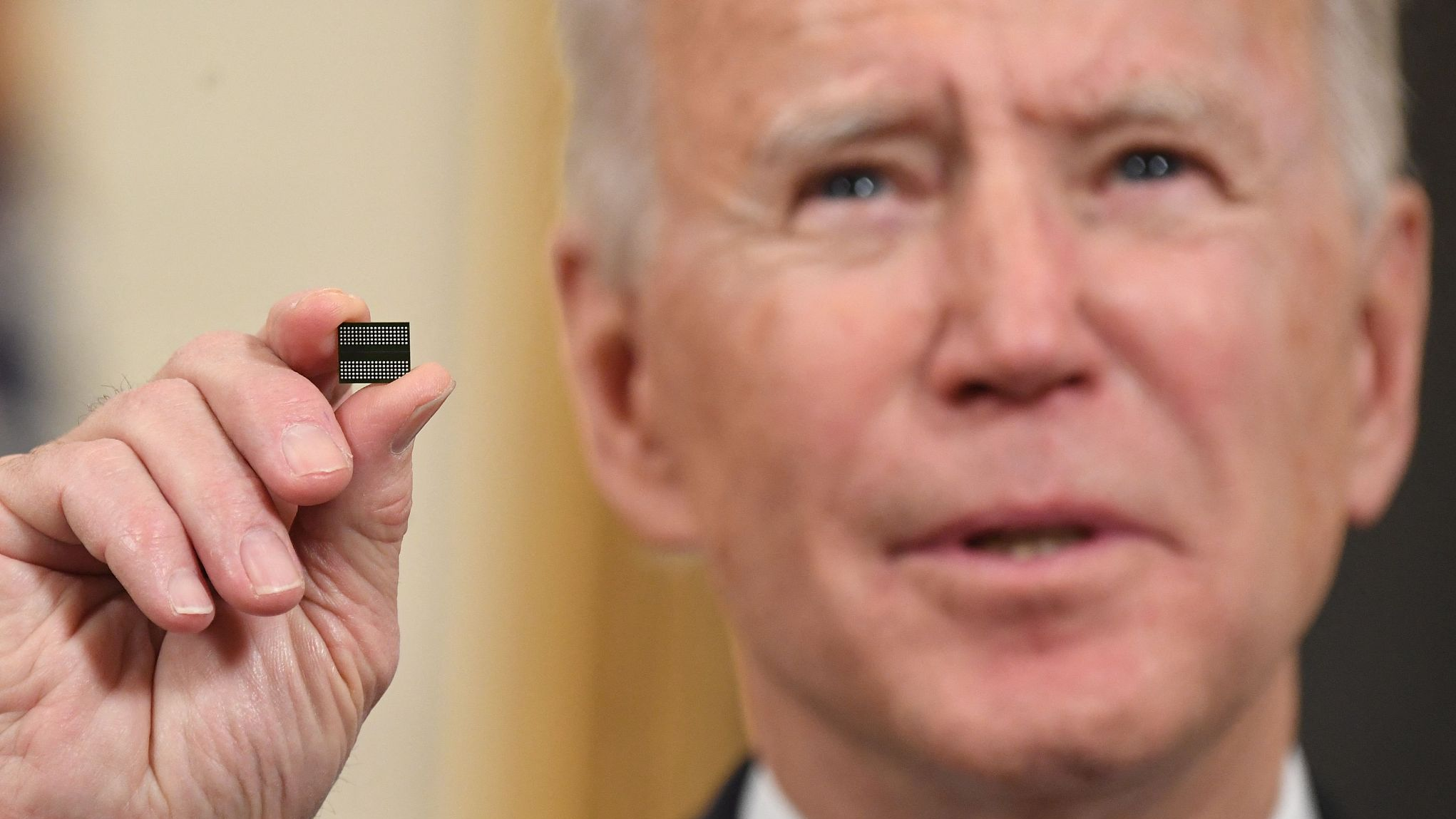
U.S. President Joe Biden holds a semiconductor during his remarks before signing an Executive Order on the economy in the State Dining Room of the White House, in Washington, D.C., February 24, 2021. /Getty
U.S. President Joe Biden holds a semiconductor during his remarks before signing an Executive Order on the economy in the State Dining Room of the White House, in Washington, D.C., February 24, 2021. /Getty
Editor's note: Alessandro Golombiewski Teixeira is a former special economic advisor to the president of Brazil, and a National Thousand Talents Distinguished Professor at China's Tsinghua University.The article reflects the author's views, and not necessarily those of CGTN.
Recently, two U.S. actions to counteract China in the technology field have made headlines.
On May 12, a U.S. Senate committee passed the "Endless Frontier" act that would authorize $100 billion for basic and advanced technology research over five years to compete with China.
Another $30 billion is on the table to fund the CHIPS Act to support America's chipmaking industry.
These two proposed laws are only a portion of the countless measures that U.S. lawmakers are taking to demonstrate publicly that China needs to be confronted not only in trade but in technology leadership.
While the bills may have the phrase "for America" in their names, chipmaking is not a U.S. domestic issue. Due to the strategic position of the semiconductor industry in the global value chain, engineering technology, and national security, semiconductor is a truly global affair.
It's clear that America's actions are aimed to suppress China's semiconductor industry, a campaign that began in the former Donald Trump administration.
Global sales of semiconductors totaled $439 billion in 2020, a 6.5-percent jump from 2019, according to the Semiconductor Industry Association (SIA). America's leadership in semiconductors is a significant reason why the country has the world's largest economy and leads the most advanced technologies.
But why is America taking these actions now?
In my view, three factors are contributing. The first reason is that previous measures aimed at weakening China's semiconductors have not worked. In fact, they have resulted in an unprecedented flourishing of chip-related companies within China. China is now leading in new technologies such as ion implantation, etching and satellite development.

Integrated circuits on a Chinese-made Hisense chip displayed at the China Home Appliances and Consumer Electronics Expo, March 23, 2021. /VCG
Integrated circuits on a Chinese-made Hisense chip displayed at the China Home Appliances and Consumer Electronics Expo, March 23, 2021. /VCG
The second factor has to do with the cyclical nature of the semiconductor industry. Top investors in the advanced semiconductor industry are almost certain that in the near future the market will turn, and it will face fierce competition from catching-up companies. The gap between emerging Chinese companies, represented by Huawei and SMIC, and the leading American firms has narrowed rapidly in less than a decade.
Despite severe U.S. sanctions, in the first quarter of 2020, Huawei's Hisilicon chip design unit surpassed Qualcomm for the first time ever in smartphone semiconductors shipment in China. Ten years ago no one even believed that any Chinese company was able to design smartphone processors.
Lastly, America's recent memory of its semiconductor "trade war" with Japan is playing a part in how it is dealing with China today. In the 1980s Japanese firms began to produce chips of equivalent quality to American ones—and at a much lower cost. This caused U.S. chipmakers to lose global market share, and they turned to the government for help.
Japanese chipmakers were accused of dumping excessively cheap chips on world markets. U.S. trade hawks took up the cause in Washington, arguing that Japan's chipmaking capabilities were not only an economic dilemma but also a security threat, and to lose semiconductor dominance might even erode America's military.
The Reagan administration sprang into action, and imposed trade restrictions on Japanese firms with the 1986 Japan-United States Semiconductor Agreement. Judging that Tokyo failed to fulfill its promises, Reagan then slapped a 100-percent tariff on certain computers, television sets and power tools made in Japan.
Seldom has America used such indecent means against its strategic regional ally. It shows how important the semiconductor industry is to America. Today the strategic position of the semiconductor industry is even more essential than 30 years ago. It is almost certain that the advanced semiconductor field will continue to be the focus of future technology competition. It may be considered as a case of national defense against China.
As we could see, these recent actions have shown that the U.S. is lacking a comprehensive strategy to deal with the fast-paced economic development of China and with the real possibility of losing the leadership of strategic technological industries as the semiconductor sector. Based on these facts, the U.S Congress has decided that China is not a strategic competitor but the main economic rivalry, and it's better to compete than to collaborate.
(If you want to contribute and have specific expertise, please contact us at opinions@cgtn.com)

